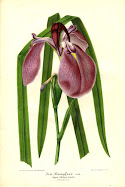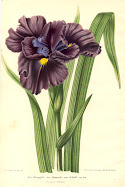 Division of Established Clumps.
Division of Established Clumps.You have just received you plant order....Gosh what can I do ?....
Some nurseryman will sell you bare root divisions from open ground. Once the order arrives, open the parcel, then soak the divisions of rhizomes in water. In the water add a very weak solution of liquid fertilizer so that the roots can take this up. After a few hours of soaking (up to 4 hours is enough to rehydrate them) they are ready for you to begin your planting.
I have brought plants from nurserymen and irises growers before from around the World so many times that it is now very easy.... For me...once the clumps of rhizomes have soaked.... I put them into large pots with a good soil potting mix.... most important is the plant label, writing the name top and bottom of the label. Labels do break now and then or are push hoed off later on, so id is important for me on those newly purchased varieties. Then I place all the pots together in a wood framed area so I can look after them much easier. Watering, weeding and light liquid feeding with fertilizer is made easy. Morning sun (4 hours minimum) and afternoon shade is a great place for them to recover and grow on. I take out my dairy and make a plan of what varieties are placed where in the cold frame. Just in case little fingers remove the labels as young children always want to play and white labels do have a fascination or push labels deep down the side of the pot. Then the following spring I would plant them out in a prepared open ground area or garden. Never leave them to soak overnight and swim.
Always keep in mind the Japanese irises love wet toes and dry ankles.
One can divide your plants either in late summer after the flowering season or early spring just as the new shoots begin to emerge.
Summer division.
One can take a division from a establish plant in the garden and divide from the plant about a month after flowering and just remove a decent size piece with soil from the growing clump.Trim back your foliage to about 25 to 30 cms high (10 to 12 inches) to reduce transpiration in the leaves. Lightly trim up any damaged roots and plant into prepared ground or in a large pot with good potting mix. The divided plant must have adequate moisture to develop new white roots at the base of the rhizomes to re-establish itself. I water daily with just a sprinkle of water to keep moist for about the first 10 days then once every 4 or 5 days from them on and as your plant begins to re-grow one can ease back on the watering. There will be some died back or browning of the old foliage as new leaves begin to appear as the plant produces new roots and recovers from its trauma.
Spring division.
In my photo's I have lifted a 3 year old clump in the very early spring while the foliage has died down and the new shoots are just beginning to emerge. I trim back the spent foliage to 10 to 15 cms ( 4 to 6 inches) so I can handle the clump better.

I take this clump to a washing area I have set up for division of my plants. I use a garden hose with a reasonable pressure to wash away the soil or mud from the dormant clump of rhizomes and clean it so you can see where to make divisions best. Once you have washed about half the soil from the clump and can see clearly where the rhizomes are, you can trim the roots to about 8 to 10 cms (3 to 4 inches) long and tidy up the top dormant foliage as well. Craft scissors I fined are the best.

I take this clump to a washing area I have set up for division of my plants. I use a garden hose with a reasonable pressure to wash away the soil or mud from the dormant clump of rhizomes and clean it so you can see where to make divisions best. Once you have washed about half the soil from the clump and can see clearly where the rhizomes are, you can trim the roots to about 8 to 10 cms (3 to 4 inches) long and tidy up the top dormant foliage as well. Craft scissors I fined are the best.

Once I have a semi clean clump in front of me I take the kitchen meat clever. Safer to handle when chopping the clump up.
I divide my clump in half and then each half into quarters, Each quarter has about 3 to 5 new shoots or rhizomes. If you divide smaller, the pieces will grow, but need extra care and will take forever to make a good sized plants again. Plea
 se don't be to mean when dividing.
se don't be to mean when dividing.Discard any old spent rhizomes.
The plant divisions are then ready to plant out in prepared garden soil and watered in or placed into a large pot with a good potting mix to grow on till you are ready to plant them out.
Again you could have a prepared area of straw on the ground in which you can line out your divisions.
Thus helping to reduce weed growth later on and to help also to retain moisture needed for the white root development and recovery
 .
.Refer to early blogs on seedlings.


















